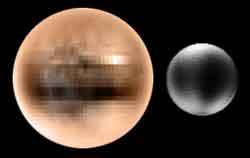|
|
Charon (shar'-un or kair'-un, Greek Χάρων) is the largest satellite of Pluto. It was discovered by astronomer James W. Christy on June 22, 1978 by carefully examining highly magnified images of Pluto on photographic plates taken a couple of months before and noticing that a slight bulge appeared periodically. Later, the bulge was confirmed on plates dating back to April 29, 1965. It received the temporary designation S/1978 P 1, according to the then-recently instituted convention. It is not to be confused with the similarly named 2060 Chiron, another object in the outer solar system with an orbit between those of Saturn and Uranus. With the discovery in 2005 of two other moons of Pluto (S/2005 P 1 and S/2005 P 2), Charon is now also referred to as Pluto I. Christy chose the name "Charon" for the moon, and this was officially accepted by the IAU in 1985. In Greek mythology, Charon was the ferryman of the dead, a figure with close ties to the god Pluto. However, Christy pronounced it differently. The ch of the mythological figure is pronounced as a k sound, like the ch in Christy's name. However, the ch in the moon's name is an sh sound, after the Christy's wife Charlene (nicknamed "Char"). The sh pronunciation is now standard among astronomers, in spite of the pleas of classicists. The discovery of Charon allowed astronomers to more accurately calculate Pluto's mass and size. Charon revolves around Pluto in 6.387 days, the same period as Pluto's rotation. The two objects are gravitationally locked (tidal locking) so they each keep the same face towards the other. Charon's diameter is 1,205 km (748.8 miles), just under half the size of Pluto. It has 1/7th the mass of Pluto, and a surface area of 4,560,000 km2. Unlike Pluto, which is covered with nitrogen ice, the Charonian surface appears to be coated with water ice. Due to the unusually small difference in size between it and Pluto, Pluto and Charon are sometimes considered to be a double planet. They are also sometimes thought of as not a planet and a satellite, but as the first two Trans-Neptunian objects. Simulation work published in 2005 by Robin Canup suggested that Charon could have formed by a giant impact around 4.5 billion years ago, with a Kuiper belt object between 1600 and 2000 kilometres in diameter striking Pluto at a speed of 1 kilometre per second and Charon coalescing from the ring of debris kicked up by the collision. There is less evidence for this theory than there is for the similar theory regarding Earth's Moon, however, most notably a lack of information regarding the composition of the two bodies. On July 11, 2005 Charon occulted the magnitude 14 star 2UCAC 2625 7135. The event was seen by three independent teams using several telescopes across southern South America. It was the first Charon occultation since 1980. The MIT-Williams College (Williamstown, Massachusetts) team (including James Elliot, Amanda Gulbis, Michael Person, Elisabeth Adams, and Susan Kern of MIT and Jay Pasachoff, Bryce Babcock, Steven Souza, and Joseph Gangestad of Williams College, working with colleagues already located in Chile and Brazil) used the 6.5 metre Clay Telescope at the Las Campanas Observatory , the 8-m Gemini South telescope on Cerro Pachón, the 2.5-m DuPont Telescope at Las Campanas, and a 0.84-m telescope of the Cerro Armazones Observatório, all in Chile and, though clouded out, a telescope at the Brazilian national observatory; they used four Portable Occultation, Eclipse, and Transit electronic-camera Systems (POETS) provided through a grant from NASA. A team headed by Bruno Sicardy of the Paris Observatory in France used one of the 8-m telescopes of the European Southern Observatory's Very Large Telescope in Chile as well as several smaller telescopes, including two that were clouded out at the same Brazilian national observatory. A team from the Southwest Research Institute in Boulder, Colorado (including Leslie Young and Elliot Young), used two telescopes in Chile, including the 4-m Blanco telescope at the Cerro Tololo Inter-American Observatory. The scientists from all the teams used information from this occultation to determine Charon's gravity, radius, and density to unprecedented precision; the results of the MIT-Williams and Paris teams appeared in the journal Nature in January 2006. The moon, along with Pluto, is to be visited by the New Horizons mission in 2015. Lnks
Marc W. Buie, Phases of Charon as seen from Pluto, Lowell Observatory Hubble reveals new map of Pluto, BBC News, 12 September 2005 IAU Circular No. 3241 [1] describing the discovery Pluto's natural satellites [edit] Charon | (S/2005 P 2) | (S/2005 P 1) Large trans-Neptunian objects Kuiper belt: Pluto (Charon) | Orcus | Ixion | 2002 UX25 | Varuna 2002 TX300 | 2003 EL61 | Quaoar | 2005 FY9 | 2002 AW197 Scattered disc: 2003 UB313 | Sedna† See also Triton, astronomical objects and the solar system's list of objects, sorted by radius or mass. For pronunciation, see: Centaur and TNO pronunciation. † Current MPC classification. Some consider Sedna an Oort cloud object. Retrieved from "http://en.wikipedia.org/"
|
|
|||||||||||||||||||||||||||||||||||||||||||||||||
